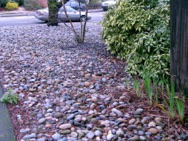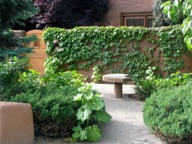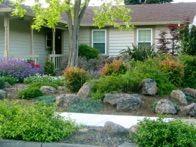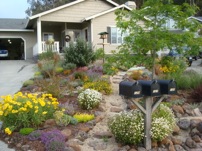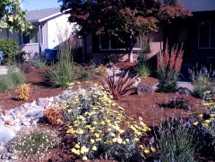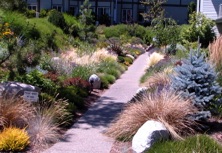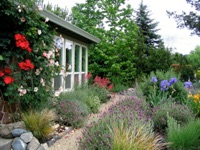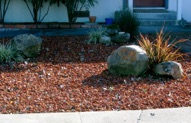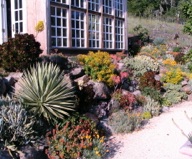Basic Landscape Design


Design Concepts to Get You Started
Volumes are written about landscape design. Four year bachelor’s and advanced degrees are awarded on the topic. But here in a page are ideas on how to begin the design of your front yard from which you have just removed the entire lawn. There’s no perfect design, but if you understand the concepts of Order, Unity, and Rhythm, you are on your way to a well-designed and pleasing front yard. (Your other choice is to spend thousands on the services of a garden or landscape designer, which is fine.)
You could mulch your entire front
yard, add a couple of placement
boulders and an ornamental grass--
very drought tolerant and low
maintenance. However, it might not
be quite the look you are trying to
achieve.
Before you begin . . .
First, drive around neighborhoods in your community. What looks good? What do you like? Take pictures. Buy several different garden and landscape magazines. Study them; cut out pictures. Go to the library and take out all the landscape design books available; pore through them. You see many ideas you like; think about why. (Look at the photos to the left. What works for you; what doesn’t?)
No doubt you keep returning to certain designs that attract you. There is probably a balance; a dominant element or focal point; and some repetition--of size, shape, texture, and color. You feel an interconnection among the elements and a proportion and scale that seem right. There’s a certain rhythm and pattern. These characteristics which you detect but perhaps cannot name, are all part of Order, Unity, and Rhythm which combine to determine good landscape design.
Getting Serious . . .
Know your growing conditions: how much sun and shade do you have, where are they during the day and the year? What kind of soil do you have--clay, loam, sand, a combination? Is it alkaline or acidic? What and when is your annual rainfall; is your goal to conserve water? What is the temperature range, scorching hot to freezing cold? Is there a slope to the front, or a depression? Will irrigation run off or puddle?
What are your homeowners’ or local
ordinances regarding lawn removal and
re-landscaping your front yard? For
instance, would you be permitted to fill
the “parking strip” or “tree lawn”
between the sidewalk and the street
with flowers and plants?
What style architecture is your home? Victorian, Spanish, Ranch, Colonial, Cape Cod, Craftsman? Boulders, rocks and ornamental grasses might not enhance your three-story Victorian. Or, an English cottage garden might not complement your South-of-the-Border adobe-style home.
Ready, Set, Draw . . .
Next, sketch a simple plot plan of your front yard. Determine which of the existing elements will stay or go--the beautiful, spring-blooming tree stays; the scraggly foundation shrubs go; the curved brick pathway to the front door stays; the pathetic little circle of petunias in the middle goes; the three stepping stones to the drive go, etc. This then is what you work with.
What hardscape features are you considering: a dry creek bed, brick pathway, retaining wall, trellis and/or fence and gate? Do these provide some balance with existing elements? Do they have a necessary function: privacy or access, sitting, security? Stand across the street, squint your eyes and imagine them.
Sketch a front elevation with some of your ideas: a set back low picket fence with trellis and gate; an 18” high rock wall along sidewalk; a winding creek bed of cobbles.
Do you want to provide some height or undulation to the neat little square of dirt in the front? Then think about bringing in a few yards of planting mix and compost for a raised planting mound (additionally, this provides better drainage).
Many communities want residents to retain as much rainwater as possible on their properties. This helps replenish the water table, keeps fertilizer, other garden chemicals, and dog waste from contaminating the storm drains and streams. The less impermeable concrete you use the better; use porous surfaces instead.
Ahhh, the Plants . . .
Local nurseries and garden centers generally sell plants that are compatible with your area’s growing conditions. Unless you have an indoor solarium, you probably won’t be buying tropical plants and cactus in North Dakota or Minnesota. You still must do your homework. Visit nurseries when plants and flowers are in bloom. Read garden books so that you know about plants’ growing requirements and mature size (i.e., look at the photo to the left with the enormous evergreen dwarfing the home).
Think about planting those which are native to your area. These will attract the local beneficial insects and thrive in the climate of your area. AND, avoid invasive plants--those which will take over your own garden, creep next door, or throw seed around the entire neighborhood.
Consider color and combinations and compatibility with your home. Do you prefer soft pastels or “hot” colors? How about the more neutral soft silver-grays or greens? Or a monochromatic design of all lavenders and purples? Or a white garden?
Develop a planting plan on paper and a plant list.
Put plants together that have similar growing requirements, especially sun and water. And remember, even though a plant may be drought tolerant or resistant, it will need regular water for the first year to become well-established.
Generally, put taller plants toward the back and plants that need less water further away. Put uneven numbers of the same plant together in groupings or drifts; our eyes prefer three of something (visually stronger) rather than four (eyes automatically divide those into twos).
Be bold, be brave, now that you’ve figured this all out, go buy your plants (wait for sales). PLANT! If you don’t like a plant in a particular place, you can always relocate it. Enjoy your garden!
©Sandy Baker 2010
